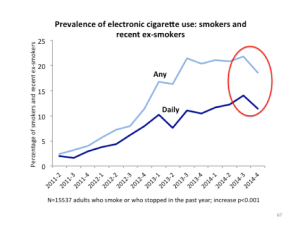On Thursday of last week The Daily Mirror newspaper, either on line or in print, carried three stories relating to e-cigarettes:
- E-cigs DON’T help smokers quit fags – in fact they make it harder to stop, written by Stephen Beech
- E-cigarette health warning: Flavoured nicotine liquid packed full of danger chemicals, researchers claim, written by Jasper Hamill
- Do e-cigarettes encourage smoking? School children more likely to try ‘vaping’ than tobacco, written by Mark Smith
And they have recently run the following front page:
The first story highlighted above, written by Stephen Beech puts forward an argument that using e-cigarettes actually makes it harder for people to quit smoking. The overwhelming body of credible evidence makes it clear that this is not actually the case: E-cigarettes actually make it easier for people to quit smoking, by offering them a viable and less harmful alternative. There are 2.1 million vapers in the UK and 700,000 of them have completely stopped smoking as a direct result of vaping. Robert West, Professor of health psychology and director of tobacco studies at University College London’s department of epidemiology and public health said: “We found that those using the e-cigarette were about 60 per cent more likely still not to be smoking than those using the licensed product or nothing at all.”[1] As e-cigarette use has risen smoking rates have fallen.
The second story highlighted above, written by Jasper Hamill states that flavoured nicotine is packed full of dangerous chemicals. This study is based on a tiny sample and crucially does not analyse the vapour that is actually breathed in by users. A number of leading toxicologists have already discounted its findings. The key conclusion in this study was for regulatory action to include requiring ingredient identification, limiting levels of some individual flavour chemicals, and limiting total levels of flavour chemicals. Many of these are things that responsible companies already do and the industry in the UK is working with the British Standards Institute on a recognised standard that will cover all of these issues.
The third story highlighted above, written by Mark Smith is very similar to the papers front page story, namely that children are trying e-cigarettes. However, when you look behind the headline you see a very different situation. The key issue is not how many children are trying e-cigarettes, but how many children having tried them then go on to become regular vapers.
Recent research produced by ASH[2] demonstrated that children are not using e-cigarettes in significant numbers. The survey found that regular use of e-cigarettes amongst children and young people is rare and is confined almost entirely to those who currently or have previously smoked[3].
Research undertaken by Queen Mary University in London[4] found that a child trying a tobacco cigarette for the first time is 50 per cent likely to become a regular smoker. The same research found no evidence that a child trying an e-cigarette for the first time goes on to become a regular vaper. A recent study by John Moores University found that, ‘Overall seven out of eight young people had never accessed e-cigarettes’[5].
What the paper’s article failed to mention was how many young people tried e-cigarettes and then went on to use them on a regular basis. There is a huge difference between trying something once and using something on a regular basis. We know from figures produced by ASH that very few young people are using e-cigarettes on a regular basis and of those that do they are confined almost entirely to those who have currently or previously smoked.[6] This is also exactly what the Cardiff University study showed. As Cancer Research UK have said, “Regular e-cigarette use is low among teens.”[7]
It is interesting how the paper chose to report this Cardiff University study because others papers took a different approach and arguably reported the study far more accurately.[8]
As a campaign representing the interests of vapers, their friends, and their families we are deeply concerned by these headlines. Not because we blindly support e-cigarettes, but because many of these headlines bear no resemblance to the articles that appear under them, more fundamentally, many of these headlines blow out of all proportion the research that the article is based on and often given undue prominence to second rate science that fails to stand up to even the most basic of expert scrutiny. One of the world’s leading experts on e-cigarettes, Dr Konstantinos Farsalinos writes regularly about this warped science narrative[9].
These headlines and others like them are now resulting in a decline in vaping as the graph below demonstrates. The latest figures produced by the authoritative Smoking in England survey[10] show that e-cigarette use in England fell in 2014 from 22 to 18.6 per cent, the lowest level since the second quarter of 2013.
Professor Robert West, said that “misleading” and “sensationalist” reports were putting smokers off switching to e-cigarettes[11]
We know from research undertaken by Dr Konstantinos Farsalinos[12] that smokers’ perceptions of risk are very far from accurately aligned with reality. This affects their smoking/vaping behaviour. In Spain a sustained period of similar misreporting of e-cigarette safety stories resulted in a 70 per cent fall in the number of vapers. These people did not just quit vaping, they went back to smoking. As Dr Konstantinos Farsalinos makes clear, it is relatively easy for a vaper to go back to being a smoker!
We know based on figures produced by ASH[13] that 99.9 per cent of vapers are former or existing smokers. The latest statistical bulletin from the Office for National Statistics on Adult Smoking Habits in Great Britain, 2013[14] shows that only 0.14 per cent of non-smokers use e-cigarettes.
When it comes to the safety of e-cigarettes it is how safe they are compared to tobacco cigarettes. We know that there is never a situation where it is better to smoke than it is to vape. All the credible evidence shows that e-cigarettes are significantly less harmful than tobacco cigarettes. Professor Peter Hajek, Director of the Tobacco Dependence Research Unit at Queen Mary University of London states that electronic cigarettes are five per cent of the risk of tobacco cigarettes, in other words at least 20 times safer than tobacco cigarettes[15]. As Professor John Britton from the Royal College of Physicians has said, “If all the smokers in Britain stopped smoking cigarettes and started using e-cigarettes we would save five million deaths in people who are alive today. It’s a massive potential public health prize.”[16]
The key health benefit of e-cigarettes is determined by how many smokers switch to them or use them as a staging post to quitting completely. It is therefore vital that media coverage of e-cigarettes is accurate and balanced.
[1] Study carried out on 5,000 smokers, by Professor Robert West looking at the success rate of different methods to stop smoking: nicotine gum, nicotine patches, nothing, or e-cigarettes. Reported on BBC Breakfast 28 April 2014
[2] http://metro.co.uk/2014/04/27/e-cigs-cleared-of-being-route-into-smoking-4710734/
[3] http://www.ash.org.uk/files/documents/ASH_891.pdf
[4] Research undertaken by Professor Peter Hajek, Director of the Tobacco Dependence Research Unit at Queen Mary University of London
[5] John Moores University – ‘Young People’s Perceptions and Experiences of Electronic Cigarettes’
[6] http://www.ash.org.uk/files/documents/ASH_891.pdf
[7] http://www.cancerresearchuk.org/about-us/cancer-news/news-report/2015-04-16-regular-e-cigarette-use-low-among-teens-analysis-suggests
[8] http://www.dailymail.co.uk/health/article-3040282/Many-teenagers-try-e-cigarettes-regular-users-study-finds.html
[9] http://www.ecigarette-research.com/web/index.php
[10] http://www.smokinginengland.info/latest-statistics/
[11] The Financial Times, 03 February 2015
[12] http://www.ecigarette-research.com/research/index.php/component/k2/item/85-the-importance-of-proper-information-risk-perception-about-e-cigarettes-is-the-strongest-predictor-of-dual-use&Itemid=213
[13] http://ecigarettereviewed.com/ash-uk-survey-adds-further-evidence-that-e-cigs-dont-appeal-to-non-smokers
[14] http://www.ons.gov.uk/ons/rel/ghs/opinions-and-lifestyle-survey/adult-smoking-habits-in-great-britain–2013/stb-opn-smoking-2013.html
[15] Professor Peter Hajek speaking at the E-cigarette Summit, The Royal Society, London on the 13th of November 2014.
[16] The Independent, 29 March 2013



makes me blooming fume BIGly…where are my worry beads?
Reblogged this on Journalot and commented:
Keep up the good work Guys.
Research on e-cigarettes is very new—there is so much we still don’t know. However, preliminary research reveals that diethylene glycol and other toxic carcinogens are found in e-cigarettes. Why take the risk?
vapor cigarettes nz